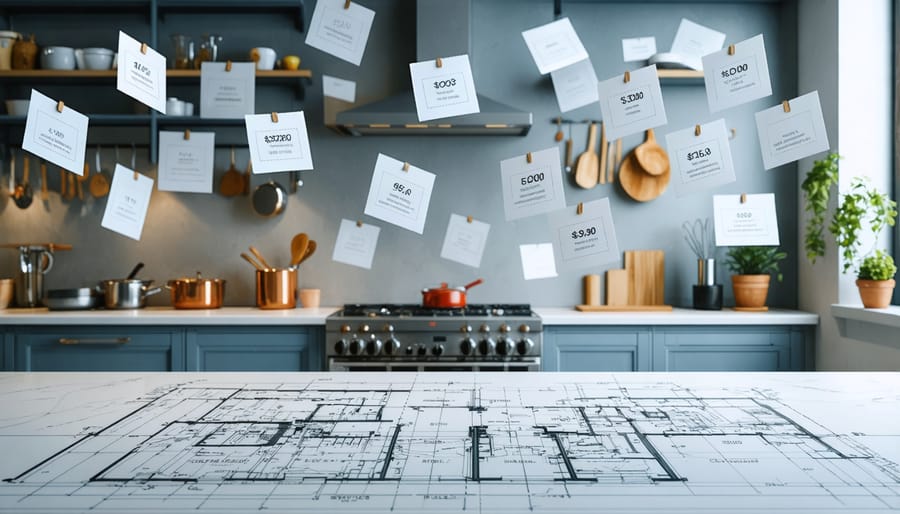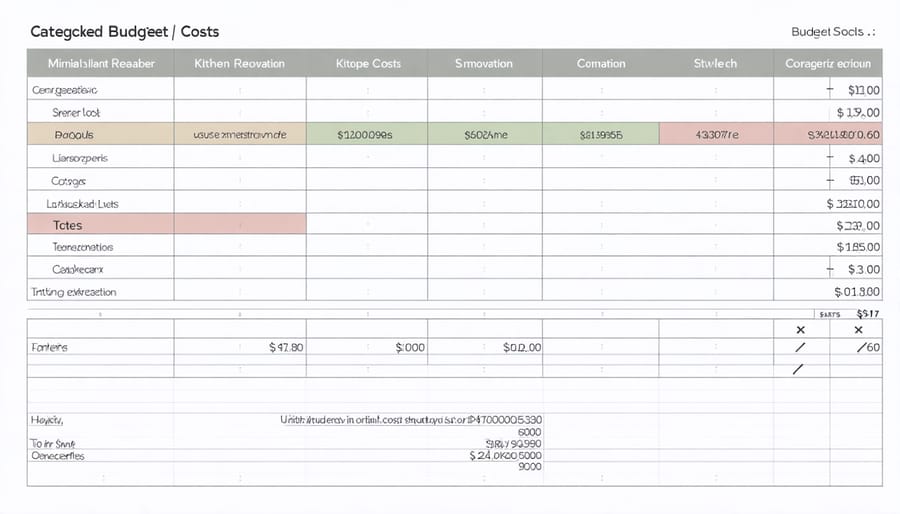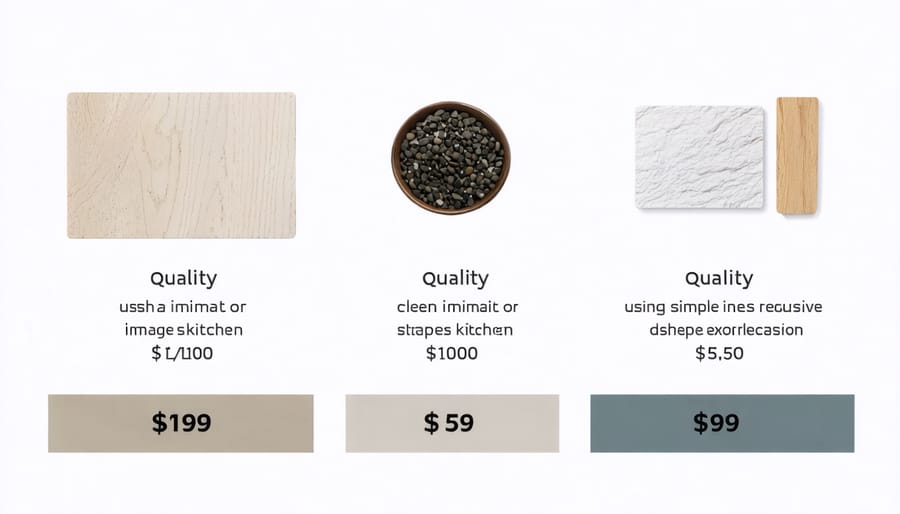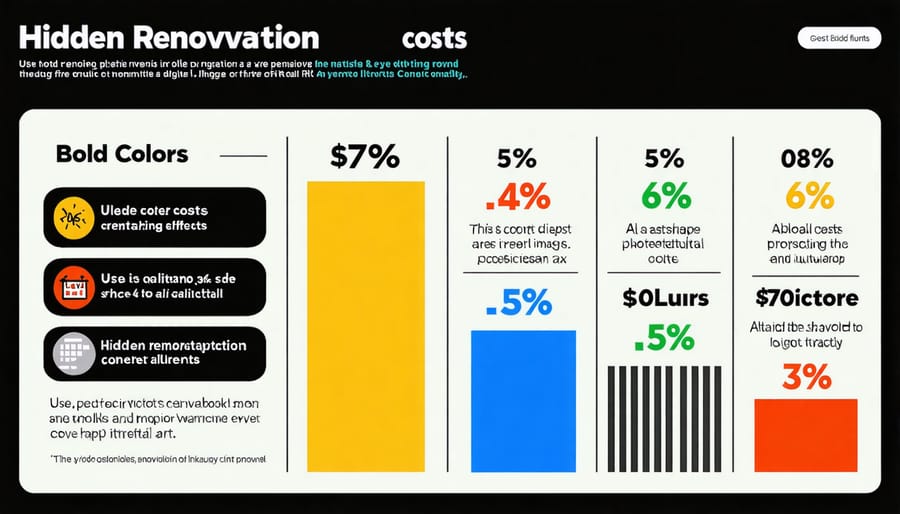
Kitchen Renovation Budget Template That Actually Saves You Money
Transform your kitchen renovation from a financial guessing game into a precisely managed project with a comprehensive budget template. Creating a detailed financial roadmap before you plan your kitchen renovation prevents costly surprises and ensures every dollar works harder. A well-structured budget template tracks everything from major expenses like cabinets and appliances to often-forgotten costs like permit fees and temporary kitchen setups.
Break down your renovation costs into clear categories: must-haves (appliances, cabinetry, countertops), wish-list items (custom features, high-end finishes), and emergency buffer funds (typically 15-20% of total budget). Factor in hidden costs that catch many homeowners off guard: delivery fees, disposal of old materials, temporary storage, and eating out during the renovation period.
Smart budgeting isn’t just about controlling costs—it’s about making informed decisions that maximize your investment’s long-term value. Whether you’re planning a modest refresh or a complete kitchen overhaul, a detailed budget template serves as your financial compass, helping you navigate decisions and track expenses with confidence.

Essential Components of Your Kitchen Budget Template
Labor Costs Breakdown
Labor costs typically account for 30-35% of your total kitchen renovation budget, making it one of the most significant expenses to consider. Your primary contractor will likely charge between $50-150 per hour, depending on your location and their experience level. Installation fees vary by task: cabinet installation usually runs $100-300 per cabinet, while countertop installation can range from $1,000-3,000 for the entire project.
Specialized labor costs often catch homeowners by surprise. Plumbers typically charge $75-130 per hour for moving or updating water lines, while electricians command $65-85 per hour for rewiring or installing new fixtures. If you’re planning to move appliances or add new outlets, expect to budget for at least 4-8 hours of electrical work.
For complex projects, you might need additional specialists: tile setters ($4-8 per square foot), painters ($20-50 per hour), and HVAC technicians ($75-150 per hour) if ventilation needs updating. Remember to factor in permit fees, which your contractor may handle but will ultimately pass on to you.
Pro tip: Always get detailed labor quotes from at least three contractors, and ensure they break down their hours by task. Some contractors offer package deals that combine multiple services, which can lead to significant savings. However, be wary of unusually low bids, as they might indicate corners being cut or hidden costs that could surface later.
Materials and Fixtures
Creating a comprehensive materials list is crucial for accurate budget planning. Let’s break down the essential components you’ll need to consider for your kitchen renovation:
Cabinetry (30-40% of budget):
– Base and wall cabinets
– Hardware (handles, hinges, drawer slides)
– Custom storage solutions
– Cabinet lighting
– Soft-close mechanisms
Countertops (10-15% of budget):
– Material options (granite, quartz, marble, butcher block)
– Edge treatments
– Backsplash materials
– Sealing products
Consider exploring sustainable kitchen materials for both environmental and long-term cost benefits.
Flooring (5-10% of budget):
– Tile, hardwood, or vinyl materials
– Underlayment
– Grout or adhesives
– Transition strips
Fixtures and Hardware (10-15% of budget):
– Sink(s) and faucet(s)
– Light fixtures
– Cabinet pulls and knobs
– Electrical outlets and covers
– Switch plates
Additional Materials:
– Paint and primers
– Drywall and joint compound
– Trim and molding
– Caulk and sealants
– Ventilation components
– Glass for cabinet doors (if applicable)
Remember to factor in a 10-15% buffer for material overages, damaged pieces, or last-minute additions. Always request samples before making final decisions, and compare prices across multiple suppliers to ensure the best value for your investment.

Appliances and Equipment
Appliances and equipment typically consume 30-40% of your kitchen renovation budget, making this category crucial for accurate planning. Start by listing your must-have major appliances: refrigerator, stove/oven, dishwasher, and microwave. Consider whether you want standard models or high-end smart appliances, as prices can range from $2,000 to $15,000 for a complete set.
Don’t forget smaller appliances that might need updating, such as coffee makers, food processors, or stand mixers. While these might seem minor compared to major appliances, they can add up quickly, typically ranging from $500 to $2,000 total.
Create two columns in your budget template: “Essential” and “Nice-to-Have.” This helps prioritize spending when costs start adding up. Include installation costs for major appliances, which typically run $100-300 per appliance, unless included in your purchase.
Pro tip: Research energy-efficient models. While they may cost more upfront, they can reduce your utility bills long-term. Also, consider timing your purchases around major sales events like Black Friday or end-of-model-year clearances to maximize savings.
Remember to factor in any specialty equipment specific to your cooking needs, such as wine fridges, warming drawers, or built-in coffee systems. Set aside 10-15% of your appliance budget as a buffer for unexpected costs or last-minute additions.

Hidden Costs to Include in Your Template
Permits and Insurance
Before swinging that first hammer, ensure you’ve accounted for all necessary permits and insurance coverage in your budget. Most municipalities require building permits for kitchen renovations, especially when structural changes, electrical work, or plumbing modifications are involved. These permits typically range from $500 to $2,000, depending on your location and project scope.
Don’t forget to review your homeowner’s insurance policy and consider temporary coverage increases during renovation. Some policies may need adjustment to cover construction-related risks. Additionally, if you’re hiring contractors, verify they carry valid liability insurance and workers’ compensation coverage. Request certificates of insurance and keep copies with your budget documentation.
It’s also worth noting that some condo associations and HOAs may require additional permits or have specific insurance requirements. Set aside approximately 3-5% of your total budget for permits and insurance-related costs. While these expenses might seem unnecessary, they protect your investment and ensure your renovation complies with local building codes and safety regulations.
Contingency Planning
Every kitchen renovation project needs a safety net, and that’s where contingency planning comes in. Experts recommend setting aside 15-20% of your total budget for unexpected issues that may arise during the renovation. This buffer helps you manage unexpected renovation challenges without derailing your entire project.
Common surprises that might tap into your contingency fund include discovering water damage behind walls, electrical systems that need updating to meet code requirements, or structural issues that weren’t visible during initial planning. These hidden problems can quickly add up, making your emergency fund crucial for project completion.
Keep your contingency money in a separate account to avoid the temptation of using it for upgrades. If you’re lucky enough not to need these funds, you can either return them to savings or use them for those wish-list items you initially cut from the budget, like that wine fridge or custom cabinet organizers.
Remember to document any contingency spending carefully, updating your budget template as you go. This helps track where emergency funds are being allocated and provides valuable insight for future renovation projects.
Customizing Your Budget Template
Every kitchen renovation project is unique, and your budget template should reflect your specific needs. Start by evaluating the scale of your renovation – are you doing a complete gut renovation or just updating certain elements? This will help determine which categories need more detailed breakdown and which can be simplified or removed.
For smaller projects, you might want to expand the materials section to include more specific items like cabinet hardware, while reducing or eliminating sections about structural changes. If you’re planning a major renovation, add categories for permits, architectural fees, and temporary kitchen setup costs.
Consider your local market when adjusting cost estimates. Research typical prices in your area and modify the template accordingly. Don’t forget to factor in whether you’re hiring professionals or doing some work yourself – this will significantly impact labor costs and timeline planning.
Customize your contingency fund based on your home’s age and condition. Older homes might need a larger buffer (15-20% of total budget) compared to newer homes (10-15%). Create additional subcategories for any special features you’re planning, such as smart appliances or custom storage solutions.
Finally, add notes sections within each category to track specific product choices, vendor contact information, and important deadlines. This personalization will transform a basic template into a comprehensive project management tool that serves your unique renovation goals.
A well-planned kitchen renovation budget template is your roadmap to a successful remodel that stays within your financial boundaries. By breaking down costs into categories, accounting for contingencies, and regularly updating your numbers, you’ll maintain better control over your project’s finances. Remember to research local material costs, get multiple contractor quotes, and always include a 20% buffer for unexpected expenses. Now that you have the tools to create your budget template, take action by downloading our customizable spreadsheet and start planning your dream kitchen renovation today. Don’t forget to review and adjust your budget regularly throughout the project, and keep all receipts and documentation organized. With proper planning and this template as your guide, you’re well-equipped to tackle your kitchen renovation with confidence.
